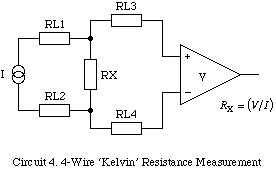Introduction
This is an introduction to some of the physical principles that underly sensors in instrument systems. It is not intended to be definitive, or very detailed, but to give the reader an idea of what is readily achievable with the various systems. I'd welcome corrections and suggestions for improvements.
This HTML document supports modules PHY3128 and PHYM203.
Resistance
Electrical resistance is the easiest electrical property to measure precisely over a wide range at moderate cost. A simple digital multimeter costing a few tens of dollars can measure resistances in the range 10 ohm to 10 megohm with a precision of about 1% using a two-wire technique (circuit 1).

The precision of the two-wire method is limited by uncertainties in the values of the lead resistances RL1 and RL2.

Providing RL1 and RL2 are well-matched, three-wire techniques can be used. Circuit 2 employs two matched current sources, I1 and I2, to eliminate the effects of lead resistance. Circuit 3 is an AC-bridge that is in-balance when RX=RY. If a lock-in amplifier is used as a null-detector, determination of RX with an extremely low excitation current is possible.

The 4-Wire 'Kelvin' method (circuit 4) is used in difficult cases when lead resistances vary, RX is very small, or when very high accuracy is required. The method is immune to the influence of lead resistance and is limited by the quality of the constant current source and voltage measurement. Thermo-electric voltages can be eliminated by averaging two measurements with the polarity of the excitation current reversed.
No comments:
Post a Comment